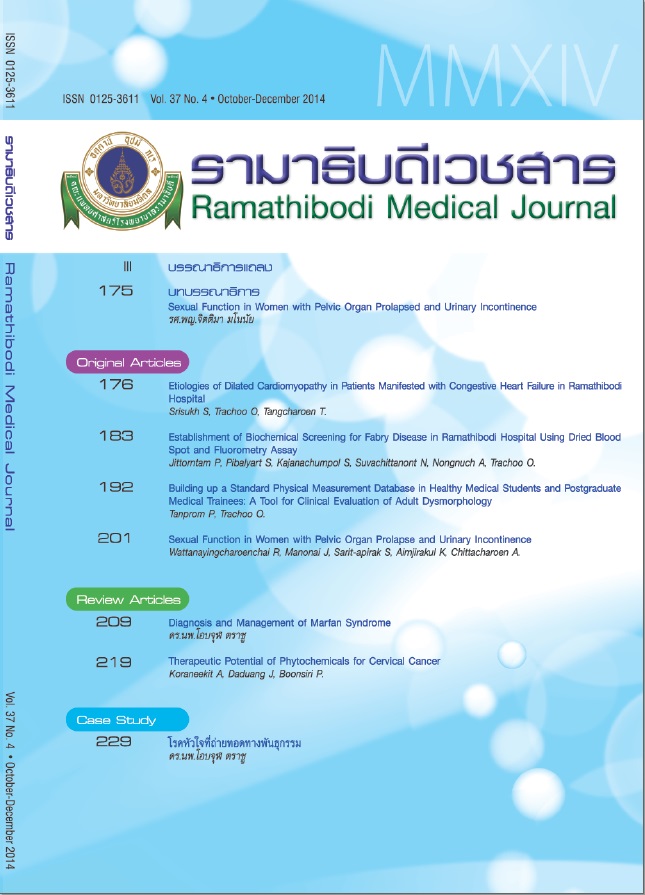Building Up a Standrad Physical Measurement Database in Healthy Medical Students and Postgraduate Medical Trainees: A Tool for Clinical Evaluation of Adult Dysmorphology
Keywords:
Measurement, Dysmorphology, Variation, Aduit, ThaiAbstract
Background: Clinical diagnosis of human dysmorphology is relied on physical examination and phenotypic characterization. However, the evaluation of adult dysmorphology is limited since most standard reference studied population of specific ethnic groups that may be not applied to Thai population.
Methods: Standard physical measurement was performed in Thai medical students and medical trainees at the age of 20 - 35 years. Past medical history was screened by face-to-face interview to exclude an individual with chronic illness. Hence, the recruited subjects were assumed to represent healthy population. The measurement procedure was based on standard technique worldwide include height, body mass index, several craniofacial and limb parameters.
Results: Total 186 individuals (96 males and 90 females) were recruited for this study. The mean sge was 27.20 ± 2.90 years (male 26.92 ± 2.88, female 27.53 ± 2.85). Physical measurement data was defined as mean ± standard deviation in males and females, respectively. The height was 174.60 ± 5.10 and 160.15 ± 4.67 cm. The head circumference was 57.47 ± 1.36 and 54.73 ± 1.45 cm. Facial length (forehead to chin) was 17.56 ± 1.07 and 16.13 ± 1.02 cm. Intercanthal distance was 3.43 ± 0.28 and 3.29 ± 0.26 cm. Interpupillary distance was 6.47 ± 0.31 and 6.17 ± 0.33 cm. Ear length was 6.59 ± 0.40 and 6.09 ± 0.35 cm. Mouth length was 5.28 ± 0.48 and 4.97 ± 0.47 cm. Middle finger length was 8.21 ± 0.39 and 7.54 ± 0.43 cm. Palm length was 11.18 ± 0.57 and 10.09 ± 0.49 cm. Sole length was 23.68 ± 1.14 and 21.37 ± 1.10 cm. Centile charts were constructed for future clinical use.
Conclusions: These physical parameters represent the normal variation of adult healthy individuals. This information is a useful reference for diagnosis of adult dysmorphology in Thai ethnic group.
References
Allanson JE, Biesecker LG, Carey JC, Hennekam RC. Elements of morphology: introduction. Am J Med Genet A. 2009;149A(1):2-5. doi: 10.1002/ajmg.a.32601.
Ward RE. Facial morphology as determined by anthropometry: keeping it simple. J Craniofac Genet Dev Biol. 1989;9(1):45-60.
Guest SS, Evans CD, Winter RM. The Online London Dysmorphology Database. Genet Med. 1999;1(5):207-212.
Ward RE, Jamison PL, Farkas LG. Craniofacial variability index: a simple measure of normal and abnormal variation in the head and face. Am J Med Genet. 1998;80(3):232-240.
Allanson JE, Cunniff C, Hoyme HE, McGaughran J, Muenke M, Neri G. Elements of morphology: standard terminology for the head and face. Am J Med Genet A. 2009;149A(1):6-28. doi:10.1002/ajmg.a.32612.
Hunter A, Frias JL, Gillessen-Kaesbach G, Hughes H, Jones KL, Wilson L. Elements of morphology: standard terminology for the ear. Am J Med Genet A. 2009;149A(1):40-60. doi:10.1002/ajmg.a.32599.
Hennekam RC, Cormier-Daire V, Hall JG, Méhes K, Patton M, Stevenson RE. Elements of morphology: standard terminology for the nose and philtrum. Am J Med Genet A. 2009;149A(1):61-76. doi:10.1002/ajmg.a.32600.
Biesecker LG, Aase JM, Clericuzio C, Gurrieri F, Temple IK, Toriello H. Elements of morphology: standard terminology for the hands and feet. Am J Med Genet A. 2009;149A(1):93-127. doi:10.1002/ajmg.a.32596.
Oostdijk W, Grote FK, de Muinck Keizer-Schrama SM, Wit JM. Diagnostic approach in children with short stature. Horm Res. 2009;72(4):206-217. doi:10.1159/000236082.
Cakan N, Kamat D. Short stature in children: a practical approach for primary care providers. Clin Pediatr (Phila). 2007;46(5):379-85.
MacLachlan C, Howland HC. Normal values and standard deviations for pupil diameter and interpupillary distance in subjects aged 1 month to 19 years. Ophthalmic Physiol Opt. 2002;22(3):175-182.
Cohen MM Jr. Malformations of the craniofacial region: evolutionary, embryonic, genetic, and clinical perspectives. Am J Med Genet. 2002;115(4):245-268.
Dollfus H, Verloes A. Dysmorphology and the orbital region: a practical clinical approach. Surv Ophthalmol. 2004;49(6):547-561.
Janssen SJ. Estimation of base of middle phalanx size using anatomical landmarks. J Hand Surg. 2014;39(8):1544-1548.
Nguyen ML, Jones NF. Undergrowth: brachydactyly. Hand Clin. 2009;25(2):247-255. doi:10.1016/j.hcl.2009.02.003.
Temtamy SA, Aglan MS. Brachydactyly. Orphanet J Rare Dis. 2008;3:15. doi:10.1186/1750-1172-3-15.
Korpaisarn S, Trachoo O, Sriphrapradang C. Chromosome 22q11.2 deletion syndrome presenting as adult onset hypoparathyroidism: clues to diagnosis from dysmorphic facial features. Case Rep Endocrinol. 2013;2013:802793. doi:10.1155/2013/802793.
Trachoo O, Assanatham M, Jinawath N, Nongnuch A. Chromosome 20p inverted duplication deletion identified in a Thai female adult with mental retardation, obesity, chronic kidney disease and characteristic facial features. Eur J Med Genet. 2013;56(6):319-324. doi:10.1016/j.ejmg.2013.03.011.













